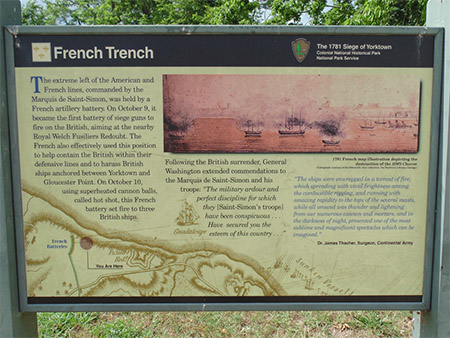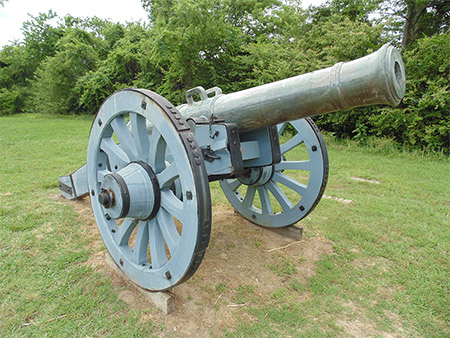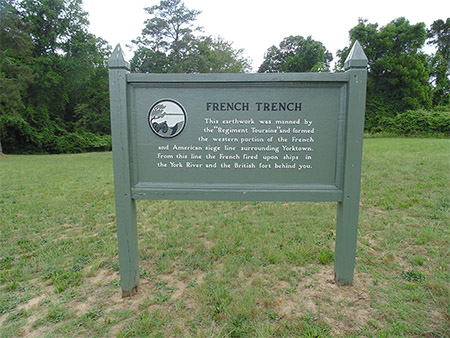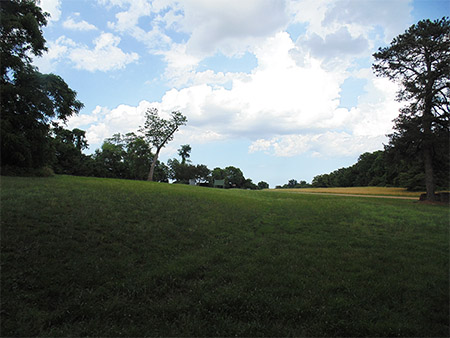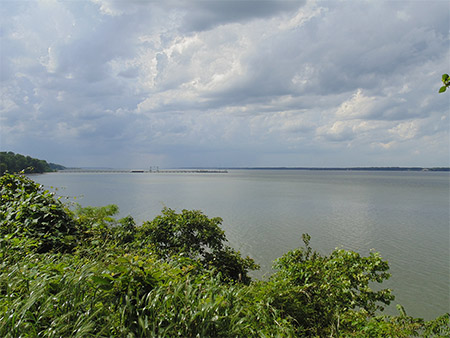Why an article about the Siege of Yorktown at a site dedicated to the Hot Shot Furnace, you may well inquire? Because an event that may have caused the United States to wholly embrace the heated shot concept in its coastal defenses occurred there, on October 10, 1781.
For much of the American Revolutionary War (1775-1781), the city of Yorktown, Virginia, was a British stronghold. It was at a strategic location that commanded the York River, an important tributary of the Chesapeake Bay.
By 1781, Yorktown was one of Great Britain's last strongholds in North America. General George Washington (1732-1799), who had combined forces with French Lieutenant General Rochambeau (1725-1807), led an army of 19,000 men into Virginia to dislodge the British once and for all.
On September 26, American and French troops began to move into the area surrounding Yorktown. Among these troops were several artillery units, which immediately began working out their angles of attack on the British defenses (although the British themselves would refer to them as defences). |
 |
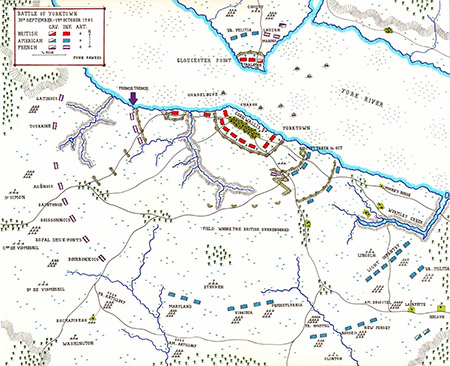 |
|
The left of the American/French lines was commanded by the Marquis de Saint-Simon (1743-1819), and at the far left was a French artillery battery, manned by the Régiment de Touraine. This battery faced the British Royal Welch Fusiliers Redoubt to the east, but also found British ships anchored betwixt Yorktown and Gloucester Point to be within its range. |
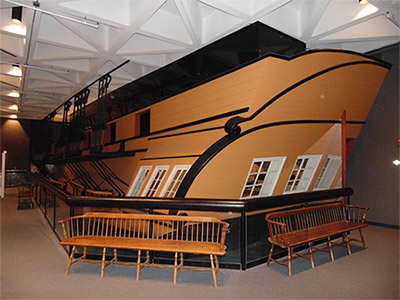 |
 |
Anchored in this vulnerable area were several British ships, including the largest ship the British had on station: A 44-gun frigate, the HMS Charon. On October 10, the French gunners fired upon the Charon with heated shot, inflicting grievous, fiery destruction to the frigate, which then blundered into a transport, setting it aflame as well. The Charon helplessly drifted to the Gloucester side of the river and burned to the waterline.
In the words of Dr. James Thatcher, a surgeon in the Continental Army:
The ships were enwrapped in a torrent of fire, which spreading with vivid brightness among the combustible rigging, and running with amazing rapidity to the tops of the several masts, while all around was thunder and lightning from our numerous cannon and mortars, and in the darkness of night, presented one of the most sublime and magnificent spectacles which can be imagined. |
|
|
I visited the Yorktown battlefield in June of 2015, having just learned of its hot shot history, and convinced that I might somehow find 230-year-old Hot Shot Furnace remnants. I hadn't yet learned that the Hot Shot Furnace hadn't even existed in 1781, and had also not considered the impossibility of a little French artillery battery in the New World having such a solid masonry structure available to it. Had it existed at that point in history. Which it did not. |
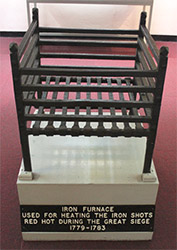
The method by which the gunners at French Trench heated their shot was probably something like this iron grate, a British design that was used to defend Gibraltar from the Spanish and French in 1782. |
 |
What I did find was French Trench, which predictably doesn't look like much of anything after 230 years. The fact that another battle had been fought at Yorktown, during the US Civil War (1861-1865), might have had something to do with the lack of Revolutionary War earthworks.
The fate of the HMS Charon, however, is a story that the battlefield park tells well. There is a quarter-sized reproduction of the Charon at the Visitor's Center, which features some of that frigate's original guns, recovered from the York River in the 1930's.
There are a great number of rebuilt artillery positions and redoubts on the battlefield, replicating the situation in 1781. To the modern eye, the positions seem so close to each other, which speaks to the range and accuracy of the artillery that was employed in 1781. |
|  |
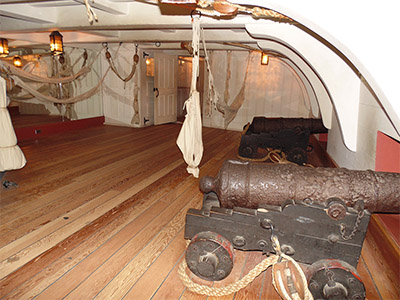 |
|
A common American attitude regarding the French today is that they're a bunch of weasely surrender monkeys, based primarily on France's performance in the Second World War (1939-1945) and, arguably, their disinterest in unquestioningly going along with the United States' strategic desires during the Cold War (1945-1990). |
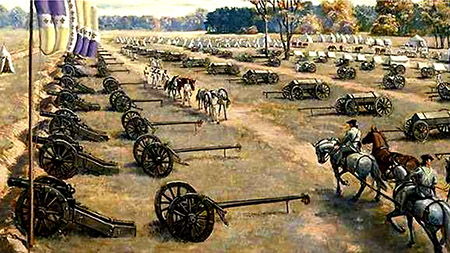 |
 |
While France's cause in this is not helped by the appearance of the flag that flies over its artillery batteries at Yorktown (solid white with three difficult-to-see-at-a-distance fleurs de lis), while at the battlefield one is reminded in no uncertain terms that France contributed enormously to the victory over Great Britain in 1781. Of the 12,000 French troops that served in America during the war, 2,112* died there. Whether France would have been as committed to the cause of American independence if supporting America hadn't been an excellent opportunity to stick it to the British Empire, during what was essentially a centuries-long war betwixt France and Great Britain, is an open question. In 1816, Simon Bernard (1779-1839) suggested to congress that many of the coastal fortifications he was designing for the United States be furnished with Hot Shot Furnaces. Congress no doubt had the fate of the HMS Charon, whose delightful, fiery destruction had come just 35 years before, firmly in mind when they agreed. |
|
Please click on any of the images on this page to view its corresponding full-sized image, plus read more of my brilliant observations, which, as we both know, is what you're really here for anyway. |
|













